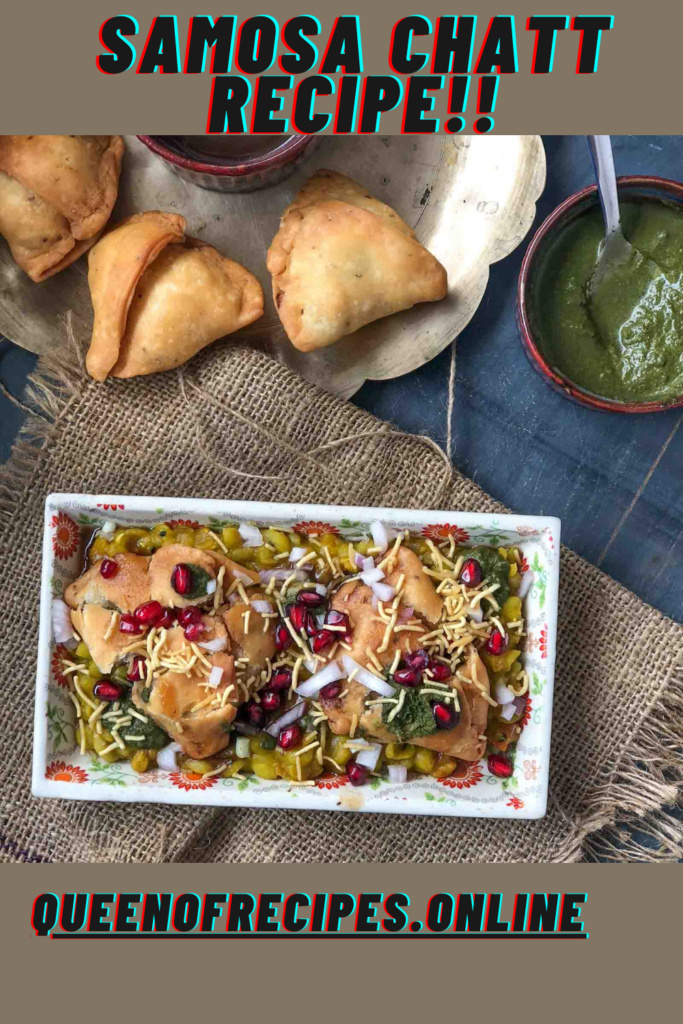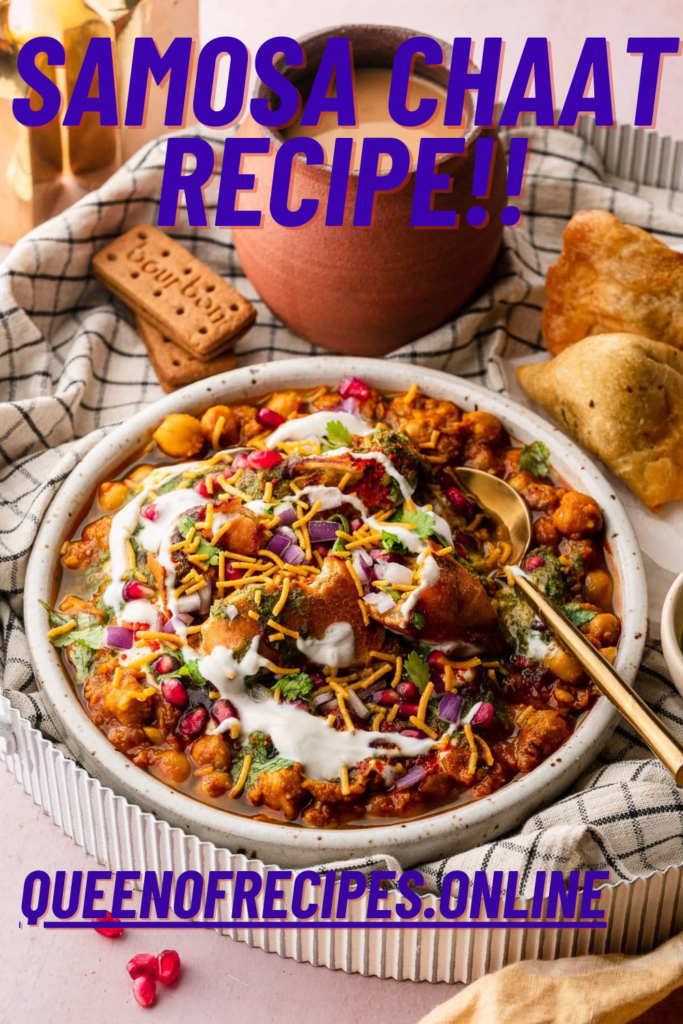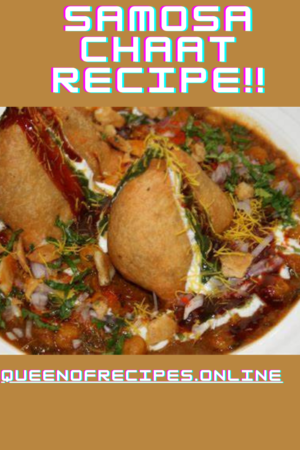Table of Contents
About Samosa Chaat.
Samosa Chaat is a popular Indian street food delicacy that combines the crispy and savory flavors of samosas with the tangy and spicy elements of chaat. In this dish, crispy samosas are crushed and topped with a variety of flavorful ingredients such as tangy tamarind chutney, spicy green chutney, creamy yogurt, crunchy sev (fried gram flour noodles), finely chopped onions, tomatoes, and fresh cilantro. The combination of textures and flavors creates a tantalizing culinary experience that is both satisfying and delicious. Samosa Chaat is loved for its irresistible taste and is often enjoyed as a snack or appetizer in India and beyond.
Here’s a recipe to make it:
Ingredients for making Samosa Chaat:
- 4-6 samosas (homemade or store-bought)
- 1 cup boiled chickpeas (optional)
- 1/2 cup finely chopped onion
- 1/2 cup finely chopped tomato
- 1/4 cup chopped coriander leaves
- 1/2 cup plain yogurt
- 2-3 tablespoons tamarind chutney
- 2-3 tablespoons green chutney (coriander-mint chutney)
- 1/4 cup sev (fried gram flour noodles)
- Chaat masala, to taste
- Red chili powder, to taste
- Salt, to taste
- Lemon wedges, for garnish
Instructions for making Samosa Chaat:
- If using store-bought samosas, reheat them in an oven or air fryer until they are crispy and hot. If using homemade samosas, ensure they are cooked and crispy.
- Once the samosas are ready, place them on serving plates. Using a spoon, crush each samosa slightly to flatten it.
- Top the crushed samosas with boiled chickpeas (if using), chopped onions, chopped tomatoes, and chopped coriander leaves.
- Drizzle plain yogurt over the samosas, followed by tamarind chutney and green chutney according to your taste preferences.
- Sprinkle chaat masala, red chili powder, and salt over the chaat for added flavor.
- Finally, garnish it with sev (fried gram flour noodles) for crunchiness.
- Serve it immediately, garnished with lemon wedges on the side for an extra burst of freshness.
- Enjoy this delicious and flavorful Samosa Chaat as a snack or appetizer!
This recipe is customizable, so feel free to adjust the ingredients and quantities according to your taste preferences.
How to make Healthier Version of Samosa Chaat.
To make a healthier version of it, you can modify the traditional recipe by incorporating healthier ingredients and cooking methods. Here’s how:
- Use Baked Samosas: Instead of deep-frying samosas, opt for baked samosas to reduce the amount of oil used in the recipe. You can either make homemade baked samosas or look for baked samosas in stores.
- Increase Vegetable Content: Add more vegetables to the chaat, such as diced cucumbers, grated carrots, or boiled peas, to increase the fiber and nutrient content of the dish. These additions also provide extra vitamins and minerals.
- Choose Low-Fat Yogurt: Use low-fat or Greek yogurt instead of full-fat yogurt to reduce the amount of saturated fat in the dish while still providing creaminess. Greek yogurt is also higher in protein, which adds to the nutritional value.
- Homemade Chutneys: Prepare homemade tamarind and green chutneys using natural sweeteners like dates or jaggery instead of refined sugar. This reduces the overall sugar content of the chutneys while maintaining the sweet and tangy flavor.
- Reduce Sev Quantity: Limit the amount of sev (fried gram flour noodles) used in the chaat to reduce the calorie and fat content. Use sev as a garnish rather than a main ingredient.
- Portion Control: Serve smaller portions of it to avoid overeating. Focus on enjoying the flavors and textures of the dish without consuming excessive calories.
- Hygiene and Freshness: Ensure all ingredients used are fresh and properly washed to maintain hygiene standards. Avoid using canned or processed ingredients whenever possible.
By making these adjustments, you can create a healthier version of it that is still delicious and satisfying, while also being more nutritious and lower in calories and fat.


Nutritional Value for Samosa Chaat.
The nutritional value of it can vary based on factors such as the size of the serving and the specific ingredients used. Here’s an approximate breakdown of the nutritional content per serving (approximately 1 serving of Samosa Chaat):
- Calories: Around 200-300 kcal
- Carbohydrates: Approximately 25-35 grams
- Protein: About 5-10 grams
- Fat: Around 10-15 grams
- Fiber: Approximately 3-5 grams
- Sodium: Varies based on salt content and additional seasoning
It’s important to note that these values are approximate and can vary depending on the specific recipe and portion size. The nutritional content can also be influenced by factors such as the type of samosas used, the amount of chutneys and yogurt added, and any additional toppings like sev or chopped vegetables.
While it can be a flavorful and satisfying snack, it’s also relatively high in calories, fat, and sodium, especially if traditional deep-fried samosas and generous amounts of chutneys and toppings are used. Enjoying it in moderation and incorporating healthier ingredients and cooking methods, as mentioned earlier, can help make it a more nutritious option.
Health Benefits of Samosa Chaat.
While Samosa Chaat is a delicious and indulgent snack, it’s important to note that its health benefits are limited due to its high calorie, fat, and sodium content. However, there are some potential benefits to consider:
- Source of Protein and Fiber: It contains ingredients like chickpeas, yogurt, and vegetables, which are sources of protein and fiber. These nutrients help promote satiety and can contribute to a balanced diet.
- Rich in Vitamins and Minerals: Depending on the ingredients used, it can provide vitamins and minerals such as vitamin C, vitamin K, folate, potassium, and magnesium from vegetables and yogurt.
- Antioxidant Properties: Some ingredients in it, such as coriander leaves and tomatoes, contain antioxidants that help protect cells from damage caused by free radicals.
- Cultural and Social Enjoyment: Enjoying it can be a cultural and social experience, fostering connections with family and friends. Sharing meals together is associated with positive mental and emotional well-being.
- Moderation and Balance: While it is not a health food, enjoying it occasionally as part of a balanced diet can contribute to overall enjoyment and satisfaction with food. It’s important to balance indulgent treats with healthier choices and portion control.
Overall, while it may not offer significant health benefits, it can be enjoyed in moderation as part of a varied and balanced diet, taking into account individual dietary preferences and nutritional needs.
Tips and Tricks for making Samosa Chaat.
Here are some tips and tricks to make delicious it:
- Use Crispy Samosas: Ensure the samosas are crispy and well-cooked before adding them to the chaat. This ensures a satisfying crunch in every bite.
- Crush Samosas Gently: When preparing the chaat, gently crush the samosas to break them into bite-sized pieces. This allows for easier mixing with the other ingredients.
- Balance Flavors: Balance the flavors of sweet, sour, spicy, and tangy by adjusting the amount of tamarind chutney, green chutney, and spices according to your preference.
- Fresh Ingredients: Use fresh and high-quality ingredients, such as ripe tomatoes, crunchy onions, and vibrant coriander leaves, to enhance the flavor and texture of the chaat.
- Layering Technique: Layer the ingredients in the chaat bowl or plate to ensure that each bite is flavorful. Start with crushed samosas, followed by chickpeas, onions, tomatoes, chutneys, yogurt, and finally, sev and garnishes.
- Chill Yogurt: If using yogurt in the chaat, chill it in the refrigerator before serving to add a refreshing contrast to the warm samosas and spicy chutneys.
- Customize to Taste: Customize the chaat to suit your taste preferences by adding or omitting ingredients like boiled chickpeas, grated carrots, or diced cucumbers.
- Serve Immediately: Serve it immediately after preparing to prevent the samosas from becoming soggy. Enjoy it while it’s fresh and flavorful!
By following these tips and tricks, you can create a mouthwatering Samosa Chaat that’s bursting with flavor and texture, perfect for any occasion.


Serving Suggestion for Samosa Chaat.
Here are some serving suggestions for it:
- Individual Portions: Serve it in individual bowls or plates for easy serving and enjoyment.
- Garnish with Fresh Herbs: Garnish each serving of Samosa Chaat with fresh coriander leaves or mint leaves for added freshness and flavor.
- Accompaniments: Serve the chaat with additional accompaniments such as lemon wedges, sliced green chilies, or pickled onions for extra zest and tanginess.
- Pair with Beverages: Pair it with refreshing beverages like masala chai, iced tea, or lemonade to balance out the flavors and refresh the palate.
- Variations: Offer different variations of it, such as adding grated cheese on top or serving it with a side of spicy salsa for a fusion twist.
- Serve as Appetizer or Snack: Present it as an appetizer at parties or gatherings or enjoy it as a satisfying snack any time of the day.
- Family-style Platter: Create a family-style platter of Samosa Chaat by arranging the crushed samosas and toppings in the center of the table, allowing everyone to customize their portions according to their taste preferences.
- Festive Occasions: Serve it during festive occasions like Diwali, Holi, or Eid, as it’s a popular street food delicacy enjoyed by people of all ages.
These serving suggestions enhance the presentation and enjoyment of it, making it a delightful and memorable dish for any meal or celebration.
FAQs for Samosa Chaat.
Can I make Samosa Chaat without yogurt?



Yes, you can make Samosa Chaat without yogurt. Simply omit the yogurt or substitute it with a dairy-free alternative like coconut yogurt for a vegan version. The chaat will still be delicious and flavorful with the combination of crispy samosas, spicy and tangy chutneys, and other toppings. Adjust the quantities of other ingredients to balance the flavors according to your preference and enjoy your yogurt-free Samosa Chaat!
How do I store leftover Samosa Chaat?



To store leftover Samosa Chaat, follow these steps:
Allow it to cool down to room temperature if it’s still warm.
Transfer the leftover Samosa Chaat to an airtight container.
Seal the container tightly to prevent air from entering.
Store the container in the refrigerator.
Consume the leftover Samosa Chaat within 1-2 days for the best taste and texture.
Before serving, you may need to refresh the chaat by adding a bit more chutney or a squeeze of lemon juice to maintain its flavor.
By following these steps, you can safely store and enjoy your leftover Samosa Chaat without compromising its taste or quality.
Is Samosa Chaat a complete meal?


Samosa Chaat can be a filling and satisfying dish, especially when it includes ingredients like chickpeas, vegetables, and chutneys. However, it may not be considered a complete meal on its own, as it typically lacks certain essential food groups like protein, grains, and a variety of vegetables. While Samosa Chaat can serve as a hearty snack or appetizer, it’s often enjoyed alongside other dishes as part of a larger meal. To make it more balanced, you can pair Samosa Chaat with additional protein sources like grilled chicken or paneer and serve it alongside a side of rice or bread for a more well-rounded meal.
Can I customize the toppings in Samosa Chaat?



Yes, you can definitely customize the toppings in Samosa Chaat according to your taste preferences. Feel free to add or omit ingredients based on what you enjoy or have available. Some common toppings include chopped onions, tomatoes, coriander leaves, green chutney, tamarind chutney, yogurt, sev (fried gram flour noodles), and chaat masala. You can also get creative and add ingredients like boiled chickpeas, grated carrots, diced cucumbers, or even some crumbled paneer for extra flavor and texture. Customize your Samosa Chaat to suit your liking and enjoy experimenting with different combinations of toppings!
Is Samosa Chaat gluten-free?



It may or may not be gluten-free, depending on the ingredients used in the samosas. Traditional samosas are made with wheat flour, which contains gluten. However, if gluten-free samosas are used or the samosas are omitted altogether, and all other ingredients and chutneys used are gluten-free, then the Samosa Chaat can be made gluten-free. It’s essential to check the ingredients list or ask about the preparation methods to ensure that the Samosa Chaat is gluten-free if you have dietary restrictions or sensitivities to gluten.

